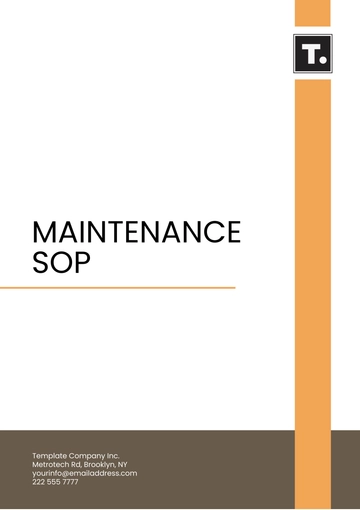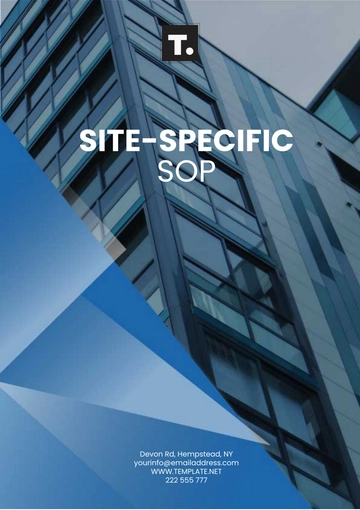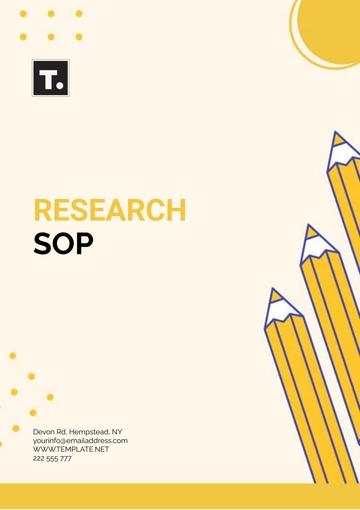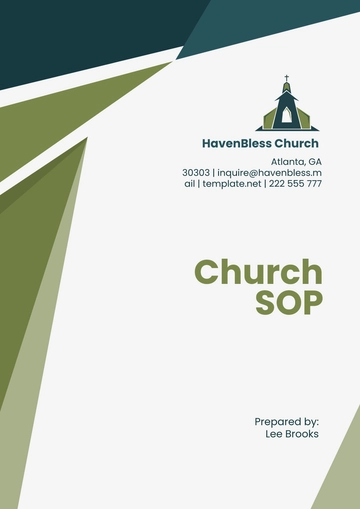Free Bakery Personal Hygiene SOP

I. Introduction
A. Purpose
[Your Company Name]'s SOP is designed to uphold the highest standards of personal hygiene within the bakery, crucial for safeguarding food safety and preventing contamination. Implementing these guidelines helps ensure that all bakery products are prepared and handled in a clean and sanitary manner, reducing the risk of foodborne illnesses. By maintaining rigorous hygiene standards, we aim to foster a safe environment for both employees and customers, thereby enhancing overall product quality and customer satisfaction.
B. Scope
[Your Company Name]'s SOP applies to all employees working in the bakery, including those involved in food preparation, handling, packaging, and cleaning. It encompasses all areas where food is processed, stored, or served, ensuring comprehensive coverage of hygiene practices. These guidelines also extend to any external personnel who may enter the bakery, such as delivery drivers or maintenance workers, to maintain a consistent standard of hygiene throughout the facility.
II. Personal Hygiene Requirements
A. General Personal Cleanliness
Employees are required to maintain high levels of personal cleanliness by showering daily and using deodorant to avoid body odor, which could impact the perception of food quality. Clean, well-maintained clothing, including bakery-specific uniforms, must be worn to prevent cross-contamination and maintain a professional appearance. All personal grooming, such as trimming nails and ensuring hair is clean and properly managed, is essential for minimizing hygiene risks in food handling areas.
B. Hand Hygiene
Proper handwashing is critical and must be performed with soap and water for at least 20 seconds before and after handling food, using the restroom, or touching any potentially contaminated surfaces. Employees should use disposable paper towels or air dryers to ensure hands are thoroughly dry, as wet or damp hands can spread bacteria. When handwashing facilities are unavailable, employees must use an alcohol-based hand sanitizer, making sure to cover all hand surfaces and allow it to dry before resuming food-related tasks.
C. Hair and Beard Management
To prevent hair from contaminating food, all employees must wear hairnets or caps that fully cover their hair while working in the bakery. This includes securing long hair in a bun or other appropriate style under the hairnet. Employees with facial hair must use beard covers to ensure that no hair falls into the food, and these covers should be replaced regularly to maintain hygiene.
III. Protective Clothing and Equipment
A. Uniforms
Throughout the various stages involved in the preparation and handling of food, it is critically important that all employees consistently wear clean aprons and gloves. This essential practice fulfills two significant roles: firstly, it helps to protect the food products from any possible contaminants that could compromise their quality and safety. Secondly, it ensures that the employees maintain a high standard of personal hygiene, thereby safeguarding their own health and well-being as they perform their duties.
In addition to this requirement, the uniforms worn by employees should be meticulously maintained, ensuring that they are devoid of stains, tears, and any other signs of wear and tear that could potentially compromise hygiene standards. In instances where clothing becomes damaged or excessively soiled, it is crucial that such clothing be promptly replaced. This immediate replacement is essential for preventing any potential hygiene issues that could arise from the continued use of compromised attire.
B. Personal Protective Equipment (PPE)
Based on the nature of the assignments or responsibilities that employees undertake, they are mandated to utilize different kinds of Personal Protective Equipment (PPE). These may include items such as gloves, masks, and aprons. The goal of using this equipment is to prevent contamination and safeguard themselves from potential hazards that could arise during the course of their work.
It is crucial for the PPE to be worn appropriately and for it to be discarded properly after each use to prevent any chance of cross-contamination. If the PPE items are designed to be reusable, they must be cleaned and sanitized following the guidelines provided by the manufacturer. This ensures that the PPE remains effective and maintains a high level of hygiene for continued use.
IV. Health and Illness Reporting
A. Reporting Procedures
It is mandatory for all employees to report any symptoms of illness they may experience, including but not limited to fever, cough, vomiting, or diarrhea, to their supervisor without delay. This prompt reporting is crucial as it allows timely and effective management of the situation, thereby significantly reducing the risk of illness spreading within the baking facility.
When employees immediately inform their supervisors about their symptoms, it enables the initiation of established protocols designed to handle such health concerns. These protocols may require the temporary exclusion of the affected employee from the workplace and a subsequent medical evaluation if deemed necessary. Ensuring that these procedures are followed is a critical step in maintaining a safe and healthy work environment for all employees.
B. Exclusion Policies
Employees who are showing any signs of contagious illnesses must be kept away from the workplace until they have been free of symptoms for a minimum of 24 hours. This is to prevent the potential spread of illness to others. In situations where the illness of an employee might impact food safety, it may be necessary for the employee to obtain medical clearance before they are allowed to return to their duties.
The bakery has instituted a series of policies specifically aimed at prohibiting employees who are ill from participating in work activities. These particular regulations are crafted with the primary objective of safeguarding the health and well-being of both the staff members and the customers who patronize the bakery. By enforcing these measures, the bakery ensures that it is able to maintain a working environment that is not only safe but also adheres to high standards of hygiene and cleanliness.
V. Training and Compliance
A. Staff Training
All employees are required to participate in an initial training session focused on personal hygiene practices as well as the specific requirements outlined in this Standard Operating Procedure (SOP). This training aims to ensure that all staff members comprehend their individual responsibilities and the critical importance of upholding hygiene standards. Furthermore, there will be continuous training sessions provided to reinforce these practices.
These ongoing sessions will also address any updates or changes in procedures and keep the staff informed about the best practices in the field. Meticulous records of all training sessions will be maintained to document employee participation. These records will serve as evidence of compliance with regulatory requirements.
B. Monitoring and Compliance
Routine hygiene evaluations are scheduled to be carried out on a consistent basis to thoroughly assess the level of adherence to the established Standard Operating Procedures (SOPs) and to pinpoint any specific areas that may necessitate enhancements or modifications. These comprehensive audits will encompass detailed inspections of hand hygiene practices to ensure proper protocol is followed. They will also scrutinize the condition and appropriateness of protective clothing worn by personnel, as well as the overall state of cleanliness within the facility.
Should any instances of non-compliance with hygiene standards be detected during these evaluations, they will be promptly addressed through a variety of corrective actions. These may include the implementation of additional training programs aimed at reinforcing proper hygiene practices, or other strategic measures designed to guarantee an ongoing commitment to high hygiene standards.
VI. Hygiene Practices for Specific Tasks
A. Food Preparation
During the process of preparing food, it is imperative that employees meticulously adhere to rigorous hygiene protocols. These protocols encompass several essential practices. First and foremost, employees are required to wear gloves to minimize the risk of contamination through direct contact with food. They must not only ensure all utensils used in food preparation are impeccably clean but also thoroughly sanitize food preparation areas and equipment before and after use to prevent cross-contamination.
Employees are also expected to routinely inspect all surfaces within the food preparation area. This includes, but is not limited to, countertops and cutting boards. These surfaces must be consistently checked to ensure they are entirely free of any residues or spills. Any such residues or spills could potentially compromise food safety if not addressed promptly and effectively. By following these comprehensive hygiene protocols, employees can significantly contribute to maintaining a safe and sanitary food preparation environment.
B. Cleaning and Sanitizing
Before beginning any cleaning tasks, employees are required to wash their hands thoroughly, taking care to remove any contaminants that might be present. This step is crucial to prevent any risk of transferring harmful substances to food or surfaces. After completing their cleaning tasks, employees must again wash their hands to eliminate any contaminants picked up during the cleaning process. Workers must use only officially approved cleaning agents and sanitizers for specific areas and equipment, and follow each product's precise usage and dilution instructions, including details on concentration, application method, and required contact time, to ensure effective sanitation.
Once the cleaning process has been completed, attention must be paid to how surfaces and equipment are dried. It is recommended to either allow them to air dry naturally or to wipe them down with clean, disposable cloths. This final step ensures not only removal of any residual moisture that might harbor bacteria or other germs but also guarantees that the surfaces and equipment are completely sanitized and safe for use.
VII. Facility Cleanliness
A. Maintenance of Clean Environment
The bakery must follow a detailed and consistent cleaning schedule that incorporates tasks to be completed on a daily, weekly, and monthly basis in order to maintain a clean and hygienic environment. On a daily basis, the cleaning tasks should encompass a thorough cleaning of high-touch areas, which include door handles and light switches, in addition to the cleaning of floors and work surfaces. Inspections will be regularly conducted to verify that all areas adhere to established hygiene standards, and these inspections will also serve to identify and address any issues that are discovered during the process.
B. Waste Management
Effective waste management practices are absolutely crucial to avert contamination and uphold hygiene standards. To achieve this, it is imperative that waste is disposed of in specifically designated containers that are clearly labeled to ensure proper identification. These waste containers must be regularly emptied and the waste removed from the bakery at consistent intervals to prevent any buildup that could pose health or safety risks. In addition, regularly cleaning and sanitizing the waste containers to remove any odors and minimize contamination is crucial for maintaining a clean bakery environment.
In addition to these practices, it is essential that all employees receive thorough training on the correct methods for handling and disposing of waste. Such training will equip them with the knowledge and skills necessary to follow the established waste management procedures effectively, thereby contributing to a safer and more hygienic bakery environment.
VIII. Documentation and Record Keeping
A. Hygiene Records
All training sessions related to personal hygiene practices will be documented, including dates, participant names, and the topics covered. These records provide evidence of compliance and support continuous improvement by highlighting areas where additional training may be needed.
Detailed records will be maintained of both hygiene inspections and any corrective actions that are implemented. This meticulous documentation will ensure a thorough and complete history of compliance with hygiene standards as well as any improvements made as a result of these actions.
B. Review and Revision
The SOP will be reviewed and updated periodically, at least annually or whenever there are significant changes in procedures, regulations, or best practices. Feedback from employees, audit findings, and regulatory changes will be considered during the review process to ensure that the SOP remains effective and up-to-date.
All modifications and changes will be formally communicated to the entire staff. Subsequently, the updated Standard Operating Procedure documents will be distributed to everyone and made readily accessible to all employees.
IX. Responsibilities
A. Staff Responsibilities
All bakery staff are responsible for adhering to the personal hygiene practices outlined in this SOP and for reporting any issues or concerns to their supervisors. Employees should actively participate in all training sessions and apply the knowledge gained to their daily tasks. It is essential for staff to maintain personal cleanliness and follow all hygiene protocols to contribute to a safe and sanitary working environment.
B. Management Responsibilities
Bakery management is responsible for ensuring that the SOP is effectively implemented and that all employees receive the necessary resources and training to comply with hygiene standards. Management will oversee the regular review and updating of the SOP to address any changes or improvements needed. Additionally, management is tasked with conducting hygiene audits, addressing non-compliance issues, and providing support to staff in maintaining high hygiene standards.
- 100% Customizable, free editor
- Access 1 Million+ Templates, photo’s & graphics
- Download or share as a template
- Click and replace photos, graphics, text, backgrounds
- Resize, crop, AI write & more
- Access advanced editor
Enhance your bakery’s hygiene standards with the Bakery Personal Hygiene SOP Template from Template.net. This editable and customizable template simplifies creating detailed SOPs tailored to your bakery’s needs. Utilize the AI Editor Tool for effortless updates and modifications, ensuring your procedures meet the highest hygiene and safety standards. Maintain a clean, professional environment with ease.





























